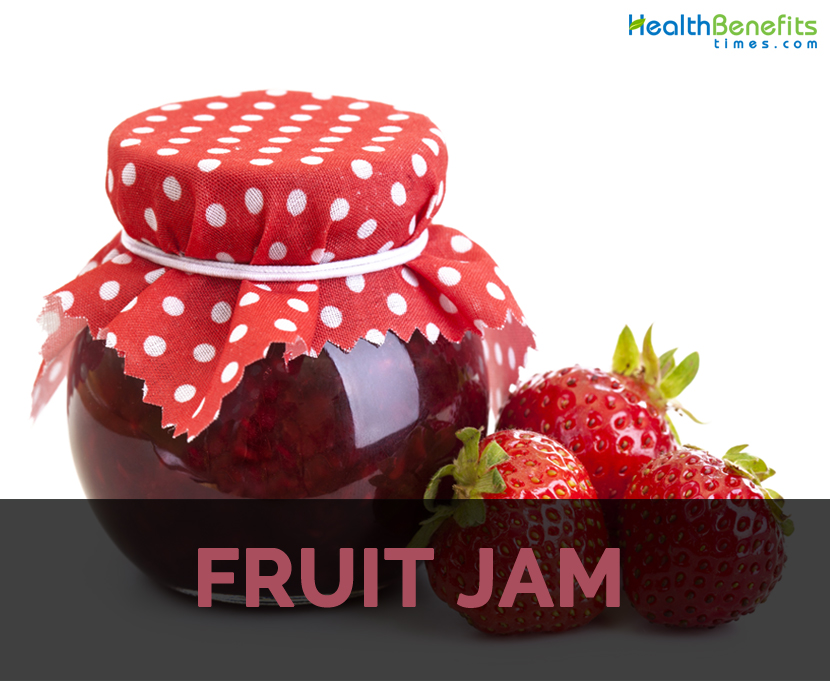| Fruit Jam Quick Facts | |
|---|---|
| Name: | Fruit Jam |
| Origin | It has a very long history. Culinary matters of cookbook of 1st century Rome has the recipes to make jam. It was used as a diet in Middle East where there is ample amounts of sugar. |
| Colors | Bright |
| Calories | 56 Kcal./cup |
| Major nutrients | Carbohydrate (10.59%) Copper (2.22%) Vitamin C (2.00%) Iron (1.25%) Vitamin B2 (1.15%) |
| Health benefits | No fat and cholesterol, Prevents cancer, Treat stroke, heart attack and cardiovascular ailments |
History
It has a very long history. Culinary matters of cookbook of 1st century Rome has the recipes to make jam. It was used as a diet in Middle East where there is ample amounts of sugar. In Britain, it was brought by Crusaders. It reached to West Indies by Spanish where the fruit was found in abundance and this method was used to preserve fruits.
The US immigrants have their own recipes of making jam but the book was prepared on 17th century. In New England, honey, molasses and maple sugar was used to provide the sweet taste.
Nutritional value
One tablespoon of jam contains 6.09 g of moisture, 569 calories, 0.07 g of protein, 0.01 g of total lipid fat, 0.05 g of ash, 13.77 g of carbohydrate, 0.2 g of dietary fiber and 9.7 g of total sugars. It also provides 0.02 mg of copper, 1.8 mg of vitamin C, 0.1 mg of iron and 0.015 mg of vitamin B2.
How to make:
Requirements:
- Fruits 2 ½ cups diced
- One lemon
- 1/4 cup sugar
- Pinch of salt
- 2 teaspoons (metal)
- Measuring cups
- Knife, cutting board
- Spatula
- Jar with lid
Instructions:
- The fruit should be cut into large chunks.
- The sugar and fruit should be mixed with a pinch of salt using a pot. Heat it to the medium till it has chunky texture.
- Boil the mixture and stir if frequently.
- When bubbles become thicker and smaller. Cook till it becomes set.
- After turning off the heat, it should be poured to the jar and screw the lid.
http://www.thekitchn.com/how-to-make-basic-fruit-jam-cooking-lessons-from-the-kitchn-193560
Health Benefits of Fruit Jam
- It does not have fat and cholesterol which helps to gain a healthy weight.
- The pectin helps to lower the chances of cancer and promotes the health of skin, hair, bones and finger nails.
- It also lowers the chances of getting stroke, heart attack and cardiovascular ailments.
- It also lowers the developments of cancers in stomach, mouth and colon rectum.
- It reduces the chances of spina bifida, neural tube defects and anencephaly in pregnant women.
Precautions
- It should be avoided by diabetic and obese patients.
- Due to the high content in sugar, it may cause tooth decay and lead to weight gain.
- It should be consumed in moderate amounts.
How to Eat
- It is eaten as a spread or fillings.
- It is used as a spread for toast and plain bread.
- It is also added to pies, puddings and ice cream.
- It is used to fill cookies and cakes.
Other Facts
Though the jam does not hold its shape, it is spreadable.
Fruit jam facts
The thick combination of sugar, pectin and fruit which is boiled lightly to make the fruit soft. It is used as a spread or fillings. It is made by whole fruit and sugar to form a gel like texture. About 45% of jam is fruit. While making jam, no artificial flavor and color is added.
| Name | Fruit Jam |
|---|---|
| History | It has a very long history. Culinary matters of cookbook of 1st century Rome has the recipes to make jam. It was used as a diet in Middle East where there is ample amounts of sugar. |
| Name in Other Languages | Arabic: murabba (مُرَبَّى); Chinese: Guǒjiàng (果酱); Brazilian Portuguese: geleia; Czech: džem; Croatian: pekmez; Dutch: jam; Danish: syltetøj; Finnish: ruuhka; European Spanish: confitura; German: Marmelade; French: confiture; Italian: marmellata; Greek: marmeláda (μαρμελάδα); Korean: jaem (잼); Japanese: Marmeláda (ジャム); Polish: dżem; Norwegian: trengsel; Romanian: gem gemuri; Portuguese: geleia; Spanish: mermelada; Russian: dzhem (джем); Thai: Yæm (แยม); Swedish: sylt; Ukrainian: varennya (варення); Turkish: reçel; Vietnamese: mứt |
| Type | Solid gels |
| Made from | Fruit pulp, sugar, juice, pectin |
| Consistency | Thick |
| Color | Bright |
| Texture | Semi-jellied |
| Flavor/aroma | Grape jelly, hot chile pepper, strawberry jelly |
| Major Nutritions | Carbohydrate 13.77 g (10.59%) Copper, Cu 0.02 mg (2.22%) Vitamin C (Ascorbic acid) 1.8 mg (2.00%) Iron, Fe 0.1 mg (1.25%) Vitamin B2 (Riboflavin) 0.015 mg (1.15%) Selenium, Se 0.4 µg (0.73%) Phosphorus, P 4 mg (0.57%) Total dietary Fiber 0.2 g (0.53%) Vitamin B9 (Folate) 2 µg (0.50%) Tryptophan 0.002 g (0.45%) |
| Health Benefits |
|
| Calories in 1 tbsp (20 gm) | 56 Kcal. |
| Precautions |
|
| How to Eat |
|
References:
https://blog.firsttunnels.co.uk/how-to-make-raspberry-jam/
https://www.collinsdictionary.com/dictionary/english/jam
http://recipes.howstuffworks.com/food-facts/types-of-jams-and-jellies.htm
https://www.lunagrown.com/fruit-jams-make-your-body-healthier/
Comments
comments
